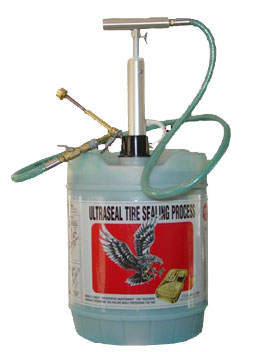Coating and Conditioning
After installation, and once the vehicle has been driven approximately 5-7km (it is not necessary to do this immediately), Ultraseal coats and clings to the tyre’s entire inner air cavity, conditioning the inner surface, eliminating porosity and bead leaks. Thixogel prevents Ultraseal from migrating to the tread area at high speeds.
AIR MIGRATION is the multitude of porous passage ways that allow air to penetrate and migrate through the tyre’s inner structure. It is next to impossible to produce a new or retreaded tyre without some air migration existing. As the vehicle is driven, tyre temperature increases, the air inside the tyre expands and air bubbles are forced into the porous passage ways. Once the air bubbles migrate into the inner structure they will continue to expand from heat. If the migrating air cannot escape through the tyre’s various plies and into the atmosphere, it will eventually cause tread separation and/or a bubble on the sidewall. If the migrating air does escape the tyre is left underinflated, either way, premature tyre failure is inevitable.
Underinflation is the #1 cause of blowouts.
Permanent Repair (safe secure repair)
When a tyre is punctured, Ultraseal is forced against and around the puncturing object by the inner air pressure, thereby preventing air from escaping. If the puncturing object is thrown out of the tyre by centrifugal force or is pulled out, the inside air forces Ultraseal into the wound and immediately stops air loss. Special fibres entwine, forming a clot, then as the rubber recovers (see rubber recovery), aided by the flexing as the tyre rotates, the inner air pressure will force the repair/clot well into and through the wound. Once Ultraseal is exposed to the outside air, a chemical curing process begins. The cured repair/clot extends well into the wound, thus providing a repair that is imperviousto water (rain, snow, mud, etc.). As this repair/clot cures, it is transposed into a permanent rubberized seal, protecting the inner casing and steel belts against contaminants entering the wound.
Rubber recovery?
Rubber recovery within a tyre, is very important in conjunction with Ultraseal. When a tyre is punctured, the rubber is forced open by the penetrating object. The wound is actually much smaller than the puncturing object. Rubber has memory and it will recover to its previous shape after being subjected to adverse conditions or stress factors.
When the penetrating object is removed, the rubber recovers and the wound closes (a tyre that is old, worn out and/or dry rotted will have little or no rubber recovery). A penetrating object left in a tyre for any extended period of time causes the rubber to temporarily lose its ability to recover. After removing the puncturing object, it is recommended to immediately flex the tyre to reactivate the rubber’s memory. As the wound closes, Ultraseal will be held in place and will create a permanent repair/clot.
Tyre flexing?
Tyres are constantly flexing when a vehicle is driven. The weight of the vehicle, the irregular surface of the road, and the turning of the tyres create a substantial amount of flexing. It is important for the Ultraseal repair/clot to be forced into and through a wound. Once this is accomplished the repair/clot cures and becomes a permanent seal.
Manual tyre flexing can be accomplished by striking the tyre repeatedly with a mallet around the wound area and/ or bouncing the tyre against the ground. This method creates a temporary repair that will become permanent once the tyre is installed onto the vehicle and is returned to service or driven approximately 3 to 5 miles.
